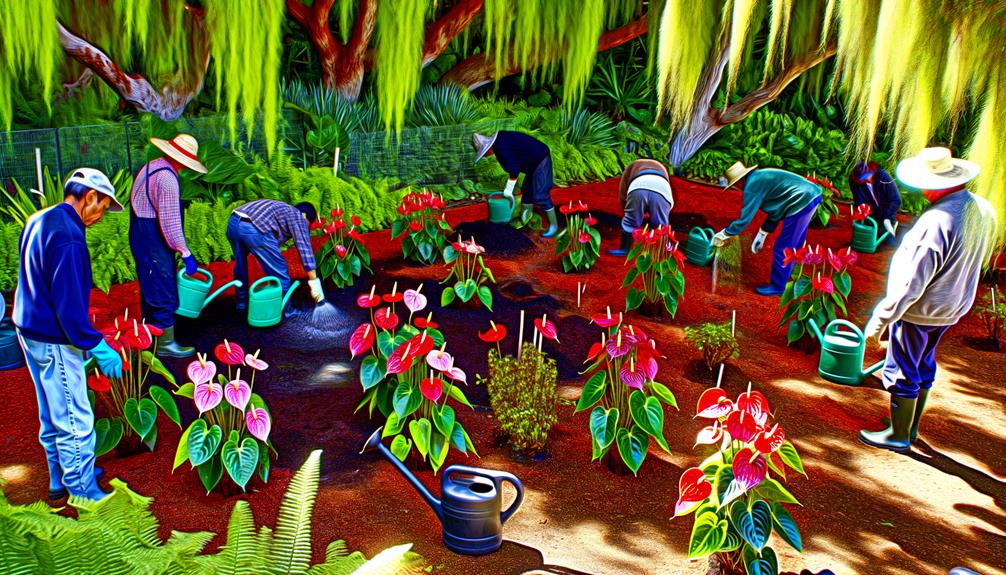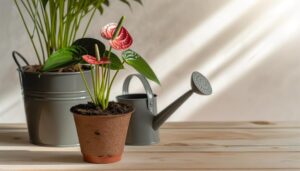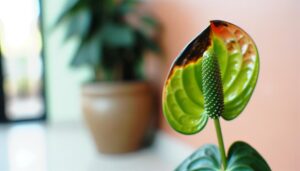10 Tips to Plant Anthurium Flowers in California
To plant anthurium flowers in California, first, choose a variety like Anthurium andraeanum that adapts well to the local microclimate. Plant between March and September.
Prepare organic-rich soil with a pH of 5.5-6.5, ensuring excellent drainage using perlite and coconut coir. Provide bright, indirect light and keep temperatures steady.
Maintain higher humidity by misting the leaves and water in the morning to avoid root rot. Use balanced fertilizer every 6-8 weeks and watch for pests.
Regular maintenance includes pruning dead leaves and checking for signs of overwatering. Explore the next steps for thriving anthuriums.

Key Takeaways
- Choose adaptable Anthurium varieties like Anthurium andraeanum suitable for California's microclimates.
- Plant between March and September to align with California's optimal growing conditions.
- Use well-draining, organic-rich soil with pH 5.5-6.5 and enhance drainage with perlite or orchid bark.
- Provide bright, indirect light and maintain indoor temperatures within the ideal range for healthy growth.
- Regularly monitor for pests and treat promptly with insecticidal soap or neem oil to maintain plant health.
Choose the Right Variety
When selecting anthurium varieties for planting in California, consider factors such as climate compatibility, growth habits, and specific care requirements to secure successful cultivation.
California's varied microclimates mean you'll need to match your chosen variety to your specific region. Opt for varieties like Anthurium andraeanum, known for its adaptability to a range of temperatures.
Assess the growth habits: some anthuriums are epiphytic, thriving on trees, while others prefer soil. Understanding these preferences secures you provide the right environment.
Additionally, research each variety's light, humidity, and water needs. Anthuriums typically require high humidity and indirect light. Some may need more frequent misting or specialized soil mixtures.
Optimal Planting Time
You should aim to plant Anthurium flowers between March and September to align with California's growing season. Consider the local climate, as these flowers thrive in temperatures ranging from 70-85°F and require high humidity.
Be aware of seasonal challenges like frost or extreme heat, which can hinder growth and damage the plants.
Best Planting Months
For ideal growth, plant Anthurium flowers in California during the mild and temperate months of spring and early fall. These periods provide the best conditions for the plants to establish and thrive.
During these months, you can expect:
- Moderate temperatures that prevent heat stress.
- Consistent moisture levels which help roots to grow robustly.
- Balanced daylight hours that support photosynthesis.
- Reduced risk of frost which can damage young plants.
- Ideal soil conditions that encourage nutrient uptake.
Climate Considerations
To ensure the best growth of Anthurium flowers in California, understanding the specific climate conditions that favor their development is crucial. Anthuriums thrive in warm, humid settings, and California's Mediterranean climate can be suitable if you manage microclimates effectively. Aim for temperatures between 70°F and 90°F and maintain humidity levels around 80%. Shield the plants from direct sunlight by providing partial shade.
Here's a quick reference table for ideal conditions:
| Factor | Best Condition |
|---|---|
| Temperature | 70°F – 90°F |
| Humidity | Around 80% |
| Sunlight | Partial shade |
| Soil Type | Well-draining, rich in organic matter |
| Watering | Keep soil consistently moist |
Seasonal Challenges
While understanding climate conditions is important, timing your planting to navigate California's distinct seasons greatly impacts the success of your Anthurium flowers.
Aim to plant in early spring when temperatures are mild and before the intense summer heat. Fall can also be suitable, as long as you avoid the first frost.
Pay close attention to the following factors:
- Temperature: Keep daytime temperatures between 70-85°F.
- Humidity: Maintain a humidity level of at least 60%.
- Sunlight: Provide indirect, filtered light to prevent leaf scorch.
- Soil: Use well-draining, organic-rich soil.
- Watering: Maintain consistent moisture without waterlogging.
Soil Preparation
To guarantee your Anthurium flowers thrive, you need to focus on ideal soil composition, proper soil pH, and good drainage and aeration.
Aim for a well-draining, organic-rich mix with a slightly acidic to neutral pH range of 5.5 to 6.5. Use a blend of peat, pine bark, and perlite to promote both moisture retention and airflow around the roots.
Ideal Soil Composition
Selecting the ideal soil composition for planting Anthurium flowers in California involves ensuring a well-draining mix rich in organic matter to support healthy root development. You'll want to prioritize these components:
- Orchid Bark: It provides excellent aeration and drainage.
- Peat Moss: Enhances moisture retention while offering organic richness.
- Perlite or Pumice: Improves soil structure and prevents compaction.
- Coconut Coir: A sustainable alternative to peat that retains moisture well.
- Compost: Adds essential nutrients and beneficial microbes.
Mixing these elements will create a thriving environment for your Anthurium flowers.
Ensuring the soil remains light and airy prevents root rot and promotes robust growth.
Proper Soil Ph
Ensuring the proper soil pH for Anthurium flowers is essential for nutrient availability and overall plant health. Aim for a soil pH between 5.5 and 6.5, which is slightly acidic to neutral. Use a pH meter or test kit to measure your soil's pH accurately. If your soil pH is too high, you can lower it by incorporating sulfur or peat moss. Conversely, if it's too low, adding lime can help raise the pH. Regularly monitor the pH levels to keep them within the best range. Below is a guide to pH adjustments:
| pH Level | Amendment | Quantity per sq. ft. |
|---|---|---|
| < 5.5 | Lime | 2-3 lbs |
| 5.5-6.5 | Best Range | – |
| > 6.5 | Sulfur/Peat Moss | 1-2 lbs |
Drainage and Aeration
After adjusting the soil pH to the optimal range, focus on enhancing drainage and aeration to prevent waterlogging and root rot in your Anthurium flowers. Proper soil preparation is essential.
Mix your soil with components like perlite, orchid bark, or coarse sand to improve its structure.
- Perlite: Boosts aeration and drainage, preventing compacted soil.
- Orchid bark: Enhances air circulation around the roots.
- Coarse sand: Adds weight and guarantees water flows freely.
- Pumice: Retains moisture without causing soggy conditions.
- Coconut coir: Balances moisture retention with excellent drainage.
Proper Drainage
Good drainage is vital for Anthurium flowers, as their roots are prone to rot if water accumulates. You should use a well-draining potting mix, ideally one composed of orchid bark, perlite, and peat moss. This combination guarantees that excess water can escape, preventing root suffocation.
When selecting a pot, make certain it has drainage holes at the bottom. These holes allow water to exit, reducing the risk of waterlogging. Additionally, placing a layer of gravel or small stones at the base of the pot enhances drainage efficiency.
Water your Anthurium only when the top inch of soil feels dry to the touch. Overwatering is a common mistake, so always lean towards caution to maintain your plants' health.
Light Requirements
Anthurium flowers thrive best in bright, indirect light, which mimics their natural tropical habitat. Direct sunlight can scorch their leaves, so place them where they receive filtered light. South or east-facing windows are ideal, but avoid direct exposure.
- Vibrant Blooms: Securing proper light will reward you with vibrant, long-lasting flowers.
- Healthy Growth: Adequate light secures robust, healthy foliage.
- Stress Reduction: Proper lighting reduces plant stress and prevents leaf browning.
- Increased Longevity: Correct light conditions extend the plant's lifespan.
- Enhanced Beauty: Bright, indirect light highlights the plant's stunning appearance.
To monitor their light needs, observe leaf color and growth patterns. Yellowing leaves may indicate too much light, while leggy growth suggests insufficient light.
Watering Schedule
To keep your Anthurium thriving, water it every week, ensuring the soil remains moist but not soggy.
Be vigilant for signs of overwatering, such as yellowing leaves and root rot.
Adjust your watering schedule based on seasonal changes and indoor conditions.
Optimal Watering Frequency
Maintaining ideal watering frequency for your Anthurium flowers in California involves understanding the region's climate and the plant's specific needs. Anthuriums thrive in consistently moist soil without becoming waterlogged. During warmer months, you should water your Anthurium about twice a week. However, in cooler months, reduce this to once a week. Always check the top inch of soil; if it's dry, it's time to water.
To promote better care for your Anthurium, consider these tips:
- Utilize well-draining soil to prevent root rot.
- Spray the leaves for higher humidity.
- Avoid direct sunlight, as it can dry the soil too quickly.
- Water in the morning to allow moisture to evaporate.
- Utilize room temperature water to avoid shocking the roots.
Maintaining this balance guarantees your Anthurium remains vibrant and healthy.
Signs of Overwatering
Given the importance of maintaining proper watering frequency, it's essential to recognize the signs of overwatering your Anthurium flowers to prevent potential damage.
Look for yellowing leaves, which indicate root rot due to excessive moisture. Soft, mushy stems are another red flag, signaling that the plant's roots are suffocating. You might also notice mold or a musty odor emanating from the soil, indicating fungal growth.
Poor growth or wilting, despite ample watering, can also be a sign of overwatering, as the roots become unable to absorb nutrients effectively. To address these issues, make sure your Anthurium's soil has excellent drainage and allow the top inch of soil to dry out between waterings.
Consistently monitor and adjust your watering schedule accordingly.
Temperature and Humidity
Anthurium flowers thrive best in environments where temperatures consistently range between 70°F and 90°F, coupled with high humidity levels around 80%.
To create the optimal conditions for your Anthurium in California, you'll need to monitor both temperature and humidity closely.
- Maintain indoor temperatures: Use a thermostat to ensure the room stays within the ideal temperature range.
- Increase humidity: Place a humidifier near the plants or use a humidity tray filled with water and pebbles.
- Avoid drafts: Keep plants away from air conditioning vents and windows that can cause temperature fluctuations.
- Group plants together: This creates a microenvironment with higher humidity.
- Mist regularly: Lightly mist the leaves to replicate their natural tropical habitat.
Fertilization Tips
To keep your Anthurium flowers healthy and thriving, use a balanced, water-soluble fertilizer every six to eight weeks during the growing season. Select a fertilizer with an equal ratio, such as 20-20-20, guaranteeing it provides essential nutrients like nitrogen, phosphorus, and potassium.
Mix the fertilizer according to the package instructions to avoid over-fertilization, which can damage roots. Apply the solution to moist soil to enhance nutrient uptake and prevent fertilizer burn. Monitor leaf color and growth; yellowing leaves could indicate nutrient deficiency, while dark green leaves with fewer flowers suggest over-fertilization.
Adjust the frequency and concentration based on your plant's response. Consistent, careful fertilization guarantees robust growth and vibrant blooms.
Pest Control
Maintaining a pest-free environment for your Anthurium flowers involves regular inspection and prompt treatment at the first sign of infestation. Check leaves and stems weekly for any signs of pests like aphids, mealybugs, and spider mites. If you spot any, act quickly by using insecticidal soap or neem oil. Make sure to isolate affected plants to prevent the spread.
- Aphids: Tiny green or black insects that suck plant sap.
- Mealybugs: White, cotton-like masses on leaves and stems.
- Spider mites: Fine webbing and tiny moving dots on foliage.
- Scale insects: Hard, brown shells attached to plant surfaces.
- Thrips: Small, slender insects that cause silvery streaks on leaves.
Regular Maintenance
Consistent care is essential for maintaining your Anthurium flowers thrive and display vibrant blooms throughout the year. Start by watering your Anthuriums regularly, keeping the soil moist but not waterlogged. Use lukewarm water and avoid wetting the leaves to prevent fungal issues.
Fertilize monthly with a balanced, water-soluble fertilizer, diluted to half strength to avoid overfeeding. Prune dead or yellowing leaves to maintain plant health and aesthetics. Ensure your Anthuriums receive bright, indirect light, as direct sunlight can scorch the leaves.
Monitor humidity levels, aiming for 60-80%, and use a humidifier if necessary. Inspect your plants frequently for pests and diseases, addressing any issues promptly. With diligent care, your Anthuriums will flourish beautifully.
Conclusion
Imagine Jane, who resides in Southern California, successfully transformed her backyard into a tropical oasis by following these 10 tips for planting anthurium flowers.
By selecting the appropriate variety, preparing the soil, and maintaining ideal light and humidity conditions, you too can enjoy vibrant, healthy anthuriums.
Secure adequate drainage, fertilize properly, and keep pests away for optimal outcomes.
With consistent upkeep, your anthuriums will flourish, adding a colorful, exotic flair to your garden.
Happy planting!






